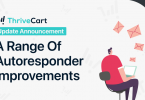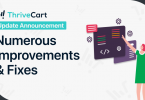One-click upsells are a proven way to increase the revenue of your business.
Customers completing micro-commitments will increase the revenue of your business
Wait… How does a one-click upsell and a series of micro-commitments both increase your revenue? Surely these statements contradict each other?
Well, you’re right. Both of these statements have been proven true, and yet both do contradict each other. So let’s take a deeper look and understand why.
Understanding 1-click upsells
First, let’s take a trip down memory lane and have a little history lesson on how and when the phrase “1-click upsell” was coined.
Purchasing online used to be a tedious task. If you wanted to offer your customers upsells after their initial purchase, it was standard procedure that your customer had to enter their personal and billing information for every upsell they wanted to buy. So if you had 3 or 4 upsells, your customer was having to enter their information this many times. So it’s no wonder that conversions on upsells were low due to this massive friction your customers had to endure.
Then, a change occurred and the ability to ‘save’ your customers details in the background rose and allowed customers to go through a sales funnel and purchase upsells without having to enter their personal and billing information again and again. Thus coining the term “1-click upsells”.
Due to this massive shift in the buying process, conversions did increase massively due to the simple fact that customers no longer had to endure filling out long checkout forms and payment details again and again.
A major misconception
Some people are obsessed with how many ‘clicks’ their visitor needs to make when purchasing due to the fear that having more than “1-click” will dramatically affect their conversions and business revenue. This is a massive misconception.
Whilst it’s true that having 1-click upsells can increase your conversions, they can also seriously impact your refund and chargeback rates. Something that is never mentioned by platforms pushing ‘1-click upsells’ as their primary feature.
It’s proven across the board both in our systems and elsewhere that offering micro-commitments in the buying process can help increase conversions but more importantly increase the revenue of your business. Let’s look at why.
If you’re focused so much on your customer needing to only click once to be charged, fearing that if they have to click twice (to confirm their purchase), you have to ask yourself, do they really want the product they have clicked to purchase? Are they the right customer for you? What does this say about the quality of your customer?
More often than not, these low-quality customers are the types of customers who end up refunding, or worse, initiate chargebacks through their bank/credit card, which can have a serious and negative impact on the relationship with your payment processor.
By offering this micro-commitment (that confirmation click) you weed out those customers who don’t really want to buy, or were likely to refund or chargeback after purchasing. This greatly improves your net revenue and decreases your refund and chargeback rate with your payment processors (and improves your relationship with them).
We’ve found that adding micro-commitments to your funnel does not have any measurable reduction in the conversion rate. By that we mean it’s zero point something of a percent (extremely low). Obviously, this can vary from niche to niche, product to product, and funnel to funnel, but the data proves that it’s extremely low across the board and the positives (increase net profit, decreased chargeback/refund rate) greatly exceed the negligible point something of a percent.
The hidden dangers
There’s also other serious implications of 1-click upsells that platforms never disclose which can have a serious impact on your business depending on what payment processors you intend to use. For example, did you know that for a platform to offer 1-click upsells via PayPal, they will own the subscription?
What this essentially means is that any recurring revenue your business has, is owned by the cart/billing platform you use. Should you ever decide to stop using them or if they cease their business and stop trading, your business will lose that recurring revenue. This can kill a business. Imagine if you woke up tomorrow and all your recurring revenue was suddenly gone.
How can you remedy this?
You can use a platform that provides these options to you. You’re wanting to look at a platform that can:
- Give you a choice of 1-click or refund/chargeback reducing based upsells in your funnel
- Create subscriptions directly with your payment processor and give you ownership of them
The good news is that ThriveCart does exactly this. We don’t force you to use a specific option of 1-click upsells or (the better) refund/chargeback reducing method.
All your payments and subscriptions are created directly with your payment processor and you personally own the subscription. So should you ever decide to stop using ThriveCart in the future (we’re not sure why you would), you would still own and receive your recurring revenue.
We understand that there are still going to be people that are heavily focused on “1-click”, so ThriveCart lets you easily set 1-click or refund/chargeback reducing confirmation steps to your sales funnels on a funnel by funnel basis. This lets you choose which funnels have which settings.
You can even easily split test against each option using our built-in split testing features!
How does it work?
The process is extremely simple and your chosen option is selected when creating your funnels for your products. You can leave the default option of “leave as one-click” or select the “refund/chargeback reducing option” instead.

When your customer goes through your sales funnel, when they decide to buy the upsell and click the purchase button, it will change colour and text asking them to confirm. All within the same button. No popup or modal window causing friction. The button simply changes asking them to confirm.








